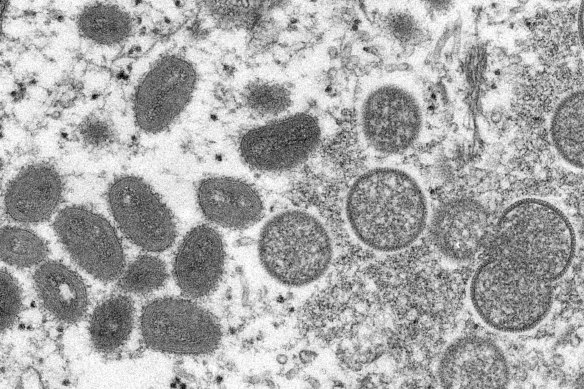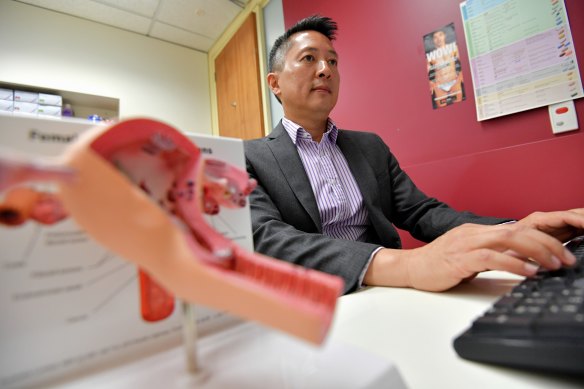Victorian health officials are racing to determine the source of more than 40 locally acquired cases of monkeypox, as doctors warn diagnosis is complicated by symptoms closely mirroring sexually transmitted infections including syphilis and herpes.
More than half of Australia’s 129 monkeypox cases have been reported in a fast-growing outbreak of the virus in Victoria. Infections in Melbourne grew again recently, and contact tracers using genomic sequencing have determined about two-thirds of the state’s 67 cases have been transmitted locally since May.

An image showing oval-shaped monkeypox virions (left) under the microscope.Credit: US Centres for Disease Control
Professor Marcus Chen, from Melbourne’s Sexual Health Centre, estimates his clinic has treated about one-third of Australia’s monkeypox cases so far. About one-quarter of the more than 40 patients his team have diagnosed have required hospital intervention, including patients with more than 100 painful lesions.
“They’re basically covered in over 100 lumps from head to toe. It can quite be disfiguring and, obviously, highly stigmatising,” Chen said. “It’s actually incredible how painful these ulcers are.”
But the experienced sexual health physician said the biggest revelation so far has been that growing numbers of his patients are presenting differently to earlier documented cases overseas, where pox-like lesions were spread across the head, limbs, chest and torso.
“A lot of the men we are treating are not presenting with the classic or traditional depiction of lesions all over their bodies,” Chen said.
“Some are presenting just like genital herpes would, with blisters and ulcers, which are very painful, clustering around their mouth, genitals or anus. Other patients have symptoms that very closely resemble syphilis, which again can present as ulcers.”
Others were arriving at the Alfred Health clinic without lesions and instead had an inflammation of the lining of the rectum known as proctitis.
The Monash University professor suspects this reflects different acquisition routes for the virus in Australia, where it is fuelled by intimate and sexual contact, compared with places such as Africa, where monkeypox is considered endemic and transmission has been reported via more fleeting contact.

Sexual health physician Marcus Chen.Credit: Joe Armao
While the vast majority of cases in Australia’s outbreak are in men who have sex with men, monkeypox can affect anyone who comes into close contact with a case.
Chen said some patients had needed heavy painkillers, such as opioids, while others required hospital treatment for a secondary bacterial skin infection, known as cellulitis, and were admitted for intravenous antibiotics.
Chen had also overseen several severe cases where the powerful antiviral Tecovirimat – which requires a sign-off from the chief health officer – has been required. This treatment has been provided to five Victorian patients.
“Fortunately, all of these cases we’ve referred to hospital have got better,” Chen said.
But worryingly, he said, many patients were unaware they had been exposed to monkeypox. Because the virus so often resembled sexually transmitted infections (STIs), staff at his clinic were now testing for monkeypox in any person who showed signs of common sexually transmitted diseases.
It is a ramp-up in testing that he wants all GPs and clinicians nationally to mirror.
“We learnt very quickly to not only test for herpes and syphilis but also monkeypox in that same swab,” Chen said. “We have been surprised to find in several cases the swab has come back as monkeypox when we thought it was a different STI.”
Chen said the clinic had administrated more than 500 vaccines to those at highest risk of contracting the virus. “The vaccines were used up very, very quickly. Demand is huge.”
There are 16 active cases in Victoria and eight people across the state have been hospitalised. A Victorian Health Department spokesman said the numbers of infections had stabilised in the past week.
According to the state government’s most recent infectious disease surveillance report, all Victorian cases of monkeypox to date have been in males aged 20 or older.
Those eligible for a monkeypox vaccine in Australia include close contacts of people infected with the virus, such as intimate partners and people who live in the same household. National health authorities continue to evaluate how to ration scarce vaccine supplies amid a global shortage.
Typically, monkeypox causes fever, chills, rash and lesions on the face or genitals. Most people recover within several weeks without requiring hospitalisation.
Those diagnosed should isolate at home for three weeks and ensure all lesions have cleared up before they have sex, and use condoms for eight weeks after infection.
Australia has acquired 450,000 doses of the new third-generation monkeypox vaccine, including 78,000 due to arrive in the last quarter of this year and 350,000 next year.
Victoria is expected to receive thousands of new doses in October.
The Morning Edition newsletter is our guide to the day’s most important and interesting stories, analysis and insights. Sign up here.